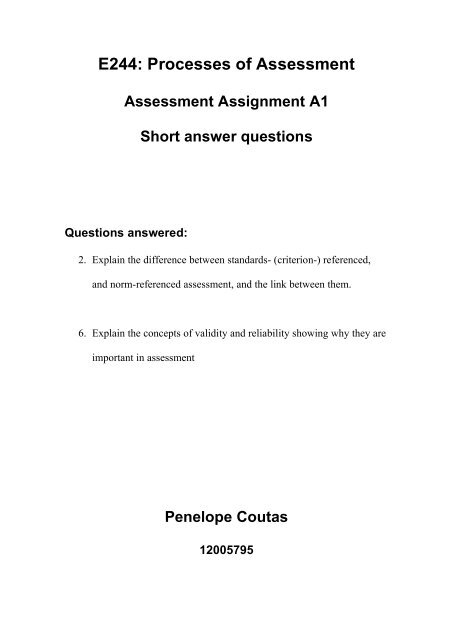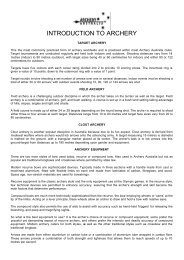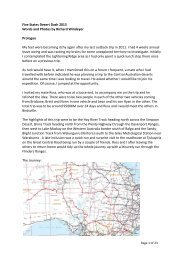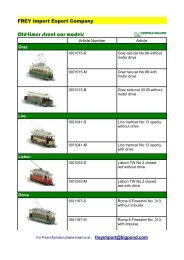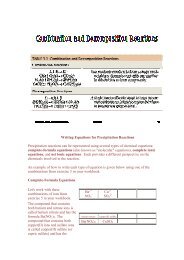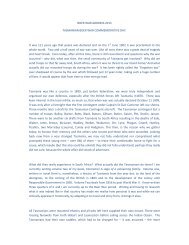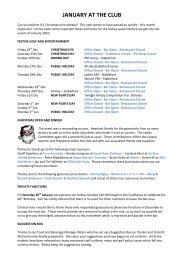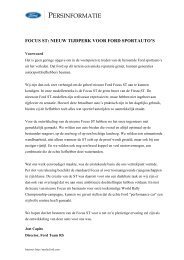Short Answer Questions
Short Answer Questions
Short Answer Questions
Create successful ePaper yourself
Turn your PDF publications into a flip-book with our unique Google optimized e-Paper software.
E244: Processes of Assessment<br />
Assessment Assignment A1<br />
<strong>Questions</strong> answered:<br />
<strong>Short</strong> answer questions<br />
2. Explain the difference between standards- (criterion-) referenced,<br />
and norm-referenced assessment, and the link between them.<br />
6. Explain the concepts of validity and reliability showing why they are<br />
important in assessment<br />
Penelope Coutas<br />
12005795
Question 2: Explain the difference between standards- (criterion-)<br />
referenced, and norm- referenced assessment, and the link between<br />
them.<br />
Two types of assessment commonly used both in schools and the wider<br />
community are norm- and standards- (criterion-) referenced assessment.<br />
These two assessment forms seem quite different: norm-referenced<br />
assessment compares individuals’ performance in relation to one another,<br />
whereas standards-referenced assessment focuses on whether the set criteria,<br />
or standards, have been met. However, there is a relationship between them,<br />
as assessment is often both standards- and norm-referenced. In the following,<br />
I will explain in more detail the difference between norm- and standardsreferenced<br />
assessment, and the link between them. It is my conclusion that<br />
both forms of assessment are useful and valid, although to different extents<br />
depending on the context in which learning and teaching takes place.<br />
Norm-referenced assessment emphasises the individual differences of learners.<br />
As Biggs and Telfer (1987, p. 137) explain, ‘in norm-referenced evaluation, the<br />
final grade … is determined by how well the student compares with other<br />
students in the class.’ Learners may also be compared with established norms<br />
of achievement, such as student performance in previous years or students<br />
from another class or school. Norm-referenced measures are most useful when<br />
we want to compare individuals’ results, and often those students are given a<br />
ranking as a result. Consequently, norm-referenced evaluation emphasises<br />
competition (Biggs and Telfer, 1987, p. 137). The most prominent example of<br />
this in Western Australian schools are the Tertiary Entrance Examinations (TEE)<br />
where all students are given a competitive Tertiary Entrance Rank (TER).<br />
Smaller scale teacher measurements may also be norm-referenced. As<br />
McInerney and McInerney (1998, p. 298) describe, ‘whenever a teacher<br />
compares an individuals’ score with the average score of the class on an<br />
activity, he or she is using a norm-referenced approach’. These scores do not<br />
give specifics about what learners actually did, but represent students’<br />
achievement in relation to the standardising group at the time.<br />
A criticism of norm-referenced assessment is that the distribution of scores is<br />
generally made to follow a bell shaped curve. This is problematic because<br />
learners who perform objectively no worse than other learners in previous years<br />
or other classes may be graded lower just because their particular reference<br />
group scores higher (McInerney and McInerney, 1998, p. 298). Additionally, in<br />
order to be fair and valid, norms should reflect the background cultural, social<br />
and learning experiences of the individuals being tested. Unfortunately, this is<br />
rarely the case (McInerney and McInerney, 1998, p. 298).<br />
An alternative to norm-referenced assessment is standards-referenced<br />
assessment. This is also called criterion-referenced assessment because the<br />
focus is on whether or not learners have satisfied the set criteria. The criteria<br />
should be explicit, and may be individualised to take into account a range of
learner characteristics (McInerney and McInerney, 1998, p. 299). Criteria may<br />
also be set for a whole class (i.e., are syllabus-specific), and scores generally do<br />
not follow a bell shaped curve. Furthermore, standards-referenced assessment<br />
does not place an emphasis on competition, and often gives specifics about<br />
student achievement and progress: very useful in formative evaluation<br />
processes.<br />
Forms of evaluation that assesses whether students have achieved a particular<br />
outcome of the Curriculum Framework (1998), and to what level as indicated by<br />
The Curriculum Framework Progress Maps (2003) are examples of standardsreferenced<br />
assessment. Teachers may use a range of assessment strategies to<br />
determine whether students have met the criteria of a particular level, and<br />
hence are ready to progress to the next stage. In a multi-levelled classroom,<br />
standards-referenced assessment is often more valid than norm-referenced: if<br />
one student is working at level two and another at level four, it hardly seems<br />
fair to award them grades based on a norm-referenced approach.<br />
One link between standards- (criterion-) and norm-referenced assessments is<br />
that tests may be both standards- and norm- referenced. A student may be<br />
assessed against set criteria, but their evaluation is influenced by comparison to<br />
the work of other students. For example, this assignment has set criteria<br />
concerning whether the question has been addressed, structure, referencing<br />
and so on. However, some students may answer their chosen question better<br />
than others, and thus be awarded a higher grade according to their<br />
comparative performance.<br />
Another link between standards- and norm-referenced assessments is that<br />
criteria are often set according to the comparative work of individuals, i.e.,<br />
using norm-determined standards (Biggs and Telfer, 1987, p. 467).<br />
Theoretically in standards-referenced assessment, criteria should be set before<br />
the learning takes place and the task completed. If they are set afterwards, the<br />
criterion becomes less of a criterion than a norm (McInerney and McInerney, p.<br />
299). In many cases, the issue is one of emphasis (E244 Unit Materials, 2003,<br />
p. 1.6).<br />
Therefore, although norm- and standards-referenced assessments take quite<br />
different approaches, there is a strong relationship between them – they are<br />
constructed using similar criteria, and the extent to which an assessment is said<br />
to be norm- or standards-referenced may only be one of emphasis. In K-10<br />
classes, it is increasingly more common for teachers to use criterion-referenced<br />
assessment due to the outcomes-based nature of the curriculum. However,<br />
students are often compared to one another and competitive ranking occurs.<br />
Furthermore, due to the nature of the TEE, TEE students generally undertake<br />
more norm-referenced assessments than standards-referenced, and criteria are<br />
often norm-determined standards. Since the Curriculum Framework (1998)<br />
emphasises that judgements on student progress must be based on multiple<br />
kinds and sources of evidence, the use of both norm-referenced and standardsreferenced<br />
assessment in the classroom is pedagogically sound, although one
may be more ‘valid’ than the other, depending on the learning and teaching<br />
context.<br />
Word Count: 786.
Explain the concepts of validity and reliability showing why they are<br />
important in assessment.<br />
Assessment is an essential component of the learning and teaching process,<br />
and in order to find out what students know, value and are able to do as a<br />
result of their schooling, that assessment must be valid and reliable. In the<br />
following, I will briefly explain the concepts of validity and reliability showing<br />
why they are important in assessment. The reliability and validity of<br />
assessment is central to its usefulness for….<br />
As LeFrancois (1997, p. 469) explains, ‘probably the most important<br />
characteristic of a good test from the students’ point of view is that it be fair.<br />
Indeed, fairness is emphasised throughout the Curriculum Framework (1998),<br />
and in order to be fair, assessment must first be valid. Assessment is valid if it<br />
measures what it is intended to measure (LeFrancois, 1997, p. 469), and many<br />
types of evidence should be accrued to support the validity of those<br />
measurements (McInerney and McInerney, 1998, p. 293).<br />
There are four main types of validity in assessment: face validity, construct<br />
validity, content validity and criterion-related validity. The first, face validity,<br />
refers to whether or not the assessment appears valid on the surface. That is,<br />
it looks like it is supposed to. A maths test should look like a maths test, and a<br />
language test should follow a format familiar to language students and so on.<br />
It needs to be explicit on the face of things what is expected in the assessment<br />
in order for it to be valid (E244 Unit Materials, 2003, p. 3.3).<br />
Construct validity is often seen as ‘the essential kind of validity’ (E244 Unit<br />
Materials, 2003, p. 3.1), overarching all other aspects of validity. Indeed, it<br />
may be said that face, content and criterion validity are evidence for construct<br />
validity (E244 Unit Materials, 2003, p. 3.0). In order for assessment to have<br />
construct validity, all components of the test must reflect the intended<br />
construct.<br />
A test may be reliable, but not valid.
Works Cited<br />
Andrich, D. (Compiler) (2003) E244 Processes of Assessment: Unit Materials<br />
2003. Perth: Murdoch University.<br />
Biggs, J. B. and Telfer, R. (1987) The Process of Learning (2nd ed.). Sydney:<br />
Prentice-Hall of Australia Pty Ltd.<br />
Curriculum Council Progress Maps: working version. (2003) Curriculum Council<br />
of Western Australia. Retrieved October 30, 2003, from<br />
http://www.curriculum.wa.edu.au/ProgressMaps/index.htm.<br />
Curriculum Framework. (1998) Osborne Park, WA: Curriculum Council.<br />
Lefrancois, G. R. (1997) Psychology for Teaching (9th ed.). Belmont, California:<br />
Wadsworth.<br />
McInerney, D. M. and McInerney, V. (1998) Educational Psychology:<br />
Constructing Learning (2nd ed.). Frenchs Forest, NSW: Prentice Hall Australia<br />
Pty Ltd.


